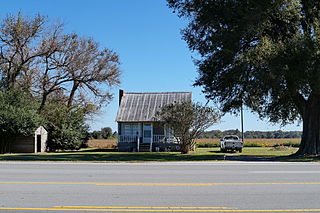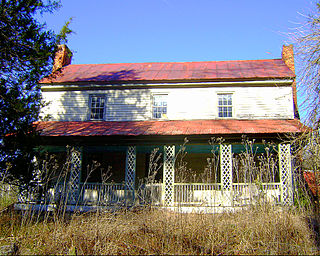Taylor Farm is a historic farm and national historic district located in Richlands, Onslow County, North Carolina. The main house was designed by Leslie N. Boney and built in 1931–1932. It is a two-story, brick dwelling with Colonial Revival and Bungalow / American Craftsman style design elements. Other contributing resources include two garages, pump house, barn, Woodward-Taylor Cemetery, silo complex, and the surrounding agricultural landscape.
Charles F. and Howard Cates Farm, also known as Swathmoor Farm, is a historic farm complex and national historic district located near Mebane, Alamance County, North Carolina. It encompasses 11 contributing buildings, 1 contributing site, and 5 contributing structures on a farm near Mebane. The district includes the two-story double-pile Cates farmhouse and a collection of outbuildings and supporting structures. These include outbuildings probably associated with pickle manufacture such as the packhouse and the office (c. 1920); outbuildings associated with dairying including the multipurpose barn, the well house, and the milk barn ; and the mule barn, gas house, tool shed, pump house, privy, and chicken house. Its owner Charles F. Cates was instrumental in establishing the Woodlawn School.

Sloan–Throneburg Farm is a historic home and farm complex located near Chesterfield, Burke County, North Carolina. The main house was built about 1882, and is a two-story, three bay, central hall plan frame I-house. Also on the property are the contributing landscape; Servant Dwelling, Ham House, and Wood Storage; Carriage House / Garage; Corncrib; Barn (1926); and Cave / Root Cellar.

John Henry Kapp Farm is a historic farm complex and national historic district located near Bethania, Forsyth County, North Carolina. The district encompasses seven contributing buildings, one contributing site, and four contributing structures dated between about 1870 and 1942. They include a two-story, frame, vernacular I-house ; smokehouse; storage shed ; shop ; chicken house (1920s); corn crib / granary; barn (1870s); fence ; corn crib / granary ; tenant house ; tobacco pack house ; and the agricultural landscape.
Baker Farm, also known as Perdue Farm, is a historic home and farm complex located near Bunn, Franklin County, North Carolina. The house was built in the first quarter of the 19th century and renovated in 1856 in the Greek Revival style. It is a two-story, three bay frame dwelling with a late-19th century two-story rear wing. Also on the property are 10 contributing outbuildings including a smokehouse, wash house, two barns, a storage shed, and three tobacco barns.
Speed Farm is a historic farm complex and national historic district located near Gupton, Franklin County, North Carolina. The district encompasses 14 contributing buildings, 2 contributing sites, and 5 contributing structures. The farmhouse was built about 1847 and remodelled to its current configuration in 1900. It is a two-story, three bay, I-house style frame dwelling. It has a gable roof and an almost full-width front porch. Also on the property are the contributing milk house, smokehouse, kitchen, family cemetery, and an agricultural complex with a granary, ram tower, barn, corn cribs, hog shed, tobacco grading building, five tobacco barns, and a tenant house.

Joseph Freeman Farm is a historic farm complex and national historic district located near Gates, Gates County, North Carolina. The district encompasses six contributing buildings, one contributing site, and three contributing structures. The main house was built about 1821, and is a two-story, two-bay dwelling in a transitional Georgian / Federal style. A separate two-room kitchen/dining room ell was added about 1915. Associated with the house are the contributing smokehouse, privy, pump house, and domestic well. Contributing farm outbuildings include the lot well, equipment shelter, feed and livestock barn, and slave / tenant house.
Obediah Winston Farm is a historic tobacco farm complex and national historic district located near Creedmoor, Granville County, North Carolina. The farmhouse was built about 1855, and is a two-story, five bay, Greek Revival style heavy timber frame dwelling. Also on the property are the contributing log outbuilding, slave house, potato house, stable, smokehouse, packhouse, tobacco barn, and tenant house.
Joseph P. Hunt Farm is a historic tobacco farm complex and national historic district located near Dexter, Granville County, North Carolina. The farmhouse was built about 1844, and is a two-story, three bay, Greek Revival style dwelling. It has a two-story rear ell dated to the 1870s and a full-width front porch added in the 1920s. Also on the property are the contributing small frame outbuilding, potato house, corn crib, two tobacco barns, smokehouse, large horse barn, packhouse, and combination icehouse/carriage house. Also on the property is the site of Breedlove Mill.
Oliver–Morton Farm is a historic tobacco farm complex and national historic district located near Oak Hill, Granville County, North Carolina. The Samuel V. Morton farmhouse was built about 1890, and is a two-story, three bay, Italianate style I-house dwelling. It has a one-story rear ell. The Oliver House dates to about 1800, and is a 1 1/2-story brick-nogged heavy timber frame building. It is one of Granville County's oldest buildings, and was converted to a packhouse in the early 20th century. Also on the property are the contributing potato house, two sheds, striphouse, and corn crib.
Ivy Burne, also known as the John Murchison Hodges, Sr. House, is a historic home and farm complex and national historic district located near Linden, Harnett County, North Carolina. It encompasses eight contributing buildings and one contributing site on a rural farm complex. The farmhouse was built in stages between 1872 and 1910, and is a two-story, vernacular Italianate / Queen Anne frame dwelling. It features a shallow, hip roofed front porch. Also on the property are a board-and-batten kitchen, a plank smokehouse, a log corn crib and tobacco barn and a frame generator house.
Summer Villa and McKay–Salmon House is a historic plantation complex and national historic district located near Lillington, Harnett County, North Carolina. It encompasses seven contributing buildings on a rural farm complex. Summer Villa was built about 1849, and is a two-story, five bay, Greek Revival style dwelling updated in the early 20th century Classical Revival style. It features a central, two-story pedimented portico supported by monumental Doric order columns with a one-story wraparound porch. The outbuildings associated with Summer Villa include the "Playhouse", carriage house, corn crib and three outbuildings. The McKay–Salmon House built in the last quarter of the 19th century and is a one-story decorated frame cottage.

Moss–Johnson Farm, also known as the Johnson Farm, is a historic farm complex located near Hendersonville, Henderson County, North Carolina, United States. The farmhouse was built between 1874 and 1880, and is a rectangular brick dwelling measuring 50 feet by 28 feet. Also on the property are the contributing clapboard summer house (1920), a granary and smokehouse (1880), a well, a barn (1923), a small dwelling (1933), and a hen house and pig barn. After 1970 the property was donated in several gifts to the Henderson County Board of Education for use as a farm museum.
Waddle–Click Farm is a historic home and farm complex located near Statesville, Iredell County, North Carolina. The Federal style house was built between about 1820 and 1835, and is a two-story, three bay by two bay, log dwelling. Also on the property are a contributing well house, smokehouse, log slave cabin, granary / corn crib, hay barn / stable, and a shed.

Bryan–Bell Farm, also known as Oakview Plantation, is a historic plantation house and farm complex and national historic district located near Pollocksville, Jones County, North Carolina. The district encompasses 25 contributing buildings, 2 contributing sites, and 2 contributing structures spread over seven areas. The main house was built about 1844 in the Federal style, and renovated in 1920 in the Classical Revival style. It is a 2+1⁄2-story, five bay, frame residence with a monumental portico with Corinthian order columns. Among the other contributing resources are the farm landscape, office (1920s), seven pack houses (1920s), equipment building, storage building, barn, two chicken houses, stable / carriage house, two garages, equipment shed, metal silo, hay barn, two tobacco barns, I-house, a log barn, a small plank building, farm house, and 19th century graveyard.
McLeod Family Rural Complex is a historic farm and national historic district located near Pine Bluff, Moore County, North Carolina. The district encompasses 10 contributing buildings, 1 contributing site, and 3 contributing structures on a family farm established in the mid-19th century. It includes two houses: the John McLeod House is a largely intact, 1 1/2-story, frame dogtrot plan house dated to about 1840. The Alex McLeod House was built in 1884, and is a two-story, five bay, traditional frame farmhouse. Other contributing resources include two tobacco barns, a pack house, fertilizer house, barn with stables, corn crib, saddle-notched log house, chicken house, shed, root cellar, and smokehouse.

Venters Farm Historic District is a historic farm complex and national historic district located near Richlands, Onslow County, North Carolina. The complex includes 23 contributing buildings. The main house was built about 1896, and is two-story frame, late Victorian farm house with a detached kitchen. Other contributing buildings include a corn barn, a carriage house, a smokehouse, mule / hay barn, cow / pig barn, eight tobacco barns, a brooder house, and seven tenant houses.
Barber Farm, also known as Luckland, is a historic farm complex and national historic district located near Cleveland, Rowan County, North Carolina. The Jacob Barber House was built about 1855, and is a two-story, single-pile, three-bay vernacular Greek Revival style frame dwelling. It has a one-story rear ell and a one-story shed roofed rear porch. Its builder James Graham also built the Robert Knox House and the Hall Family House. Other contributing resources are the cow barn, smokehouse, granary, double crib log barn, well house, log corn crib / barn, carriage house, school, Edward W. Barber House (1870s), Edward W. Barber Well House (1870s), North Carolina Midland Railroad Right-of-Way, and the agricultural landscape.
Knox Farm Historic District is a historic farm complex and national historic district located near Cleveland, Rowan County, North Carolina. The Robert Knox House was built between 1854 and 1856, and is a two-story, single-pile, three-bay vernacular Greek Revival style frame dwelling. It has a two-story rear ell, one-story rear kitchen ell. Its builder James Graham also built the Jacob Barber House and the Hall Family House. Other contributing resources are the log corn crib, reaper shed, power plan, chicken house, brooder house, log smokehouse, barn, main barn (1916), milking parlor (1948), spring house, tenant house (1920), and Knox Chapel Methodist Church (1870s).

Holbrook Farm is a historic farm complex located near Traphill, Wilkes County, North Carolina. The house was built about 1826, and is a vernacular two story, three bay frame dwelling with Federal style design elements. Also on the property are the contributing log granary, log spring house, a log smokehouse, a log corn crib, a frame barn, and a board-and-batten two-room school dormitory that once served the Trap Hill Institute and moved to the property in the early-20th century.










